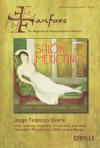Texte paru dans: / Appeared in: |
|
|
Reviewer: Robert
Maxham
Violinist
Riccardo Minasi and I Pomo d’Oro present seven violin concertos that Antonio
Vivaldi sent to Emperor Charles VI (although perhaps, according to the
Cesare Fertonani’s notes, originally composed for another patron and
redirected to Charles). The Concerto in G Minor, RV 331, opens with a
gesture that sounds bold even for Vivaldi and continues with bubbling
figuration that looks forward to generations to come. Minasi, playing a 1627
Brothers Amati, hisses and spits to sharpen the articulation’s high
definition. He creates a liquid flow of melody in the slow movement, framed
by piquant string sonorities at the beginning and end, and strikes showers
of sparks in the finale’s swirling passagework. Fertonani suggests that
Vivaldi himself may actually have played the Concerto, RV 171, dedicated to
the Imperial Catholic Majesty, in concert for the Emperor. The Concerto in B
Minor, RV 391, also appears as the 12th Concerto in op. 9, “La Cetra,” and
features a scordatura tuning for violin (in this case, b, d’, a’, d’’);
Minasi creates extra textural effects in the first movement beyond those
suggested by the tuning and produces machine-gun-like staccatos in the
finale. The Concerto in E Major also appears in what Fertonani calls the
“manuscript Cetra” but has also been referred to as “La Cetra II.” Minasi
and the ensemble play the first movement’s suave syncopations with a sweetly
melting lyricism that displays another facet of the soloist’s and ensemble’s
interpretive personalities. The Concerto in G Minor, RV 327, gives the
ensemble opportunities for subtle dynamic control in the first movement,
soaring lyricism in the second movement (when Giuseppe Tartini objected to
Vivaldi’s violinistic vocal writing he could hardly have thought of this
kind of melody). The ensemble rushes headlong in the tuttis and Minasi
follows with breathless figuration. The virtuosic Concerto in C Major, RV
263a (otherwise known as op. 9/4), with its three repeated hammer strokes,
comes, according to Fertonani, from the first two movements of RV 263, with
the finale of RV 762 tacked on. Similarly, Vivaldi assembled the Concerto,
RV 181a (op. 9/1), from the first two movements of the Concerto RV 181
(played here) and the last movement of the Concerto RV 183. Minasi includes
the alternative Allegro from RV 181a.
Those who
find almost unvaryingly crunchy cereal indigestible may not respond to Il
Pomo d’Oro’s manner—nor Minasi’s. (Further aggravating the problem for them,
Minasi’s occasionally sour timbres may seem to have the wrong pH for them—as
well as for the resonant recorded sound.) Most others should appreciate the
variety (and the brilliant, gem-like virtuosity) that underlies this general
approach and respond more warmly to its virtuosity and occasional lyricism.
| |
|
|
|
|
|
|
|
Cliquez l'un ou l'autre
bouton pour découvrir bien d'autres critiques de CD |
|




